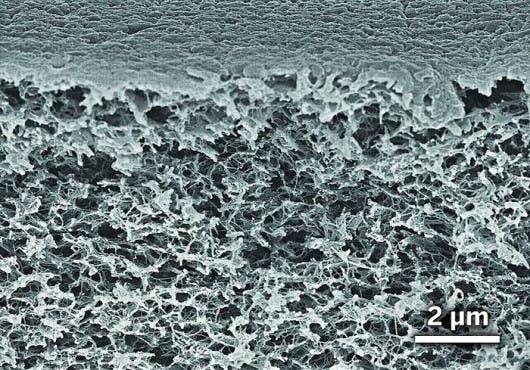Since they were first invented in 1931, aerogels have become widely used in the industry, mostly for insulation purposes, thanks to their low thermal conductivity and light weight. Traditional silica aerogels, however, are brittle and obtuse, typically unsuited for applications where flexing of the material would occur. A novel class of polymer aerogels seeks to fix most of these inconveniences, after scientists at NASA have shown that the polymer version is up to 500 times stronger and has a thermal resistance up to 10 times higher than typical silica aerosols. If proven commercially cost effective in the future, a whole super-insulation revamp might commence – from refrigeration, to clothing, to heating systems and so on.
Aerogels are basically gels where the liquid component has been replaced by a gas, through the process of supercritical drying. The resulting gel, an aerogel, has a low heat transfer and low density, since it retains its pre-treatment volume even after the water has been replaced. This makes them ideal for insulating applications, but they’ve also been used from particle physics to biomedical fields.
Their only draw back is that they’re extremely brittle, and crumble easily. Until now that is, since researchers at NASA’s Glenn Research Center in Ohio managed to create a full polymer aerogel which is just as potent as its silica counterpart, but only much more stronger. Best of all, it can be produced into thin stripes which don’t break down, allowing for insulation of sensitive parts.
“The new aerogels are up to 500 times stronger than their silica counterparts,” says Meador. “A thick piece actually can support the weight of a car. And they can be produced in a thin form, a film so flexible that a wide variety of commercial and industrial uses are possible.”

The scientists worked up from previous attempts which coated silica aerogels with polymers by chemical vapor deposition. However, most of the polymers that could be deposited in this manner have rather low melting temperatures, unfit for most applications. So the scientists took a more direct route – they formed polymer aerogels directly, without any coating. The resulting material has a resistance to temperatures of 400 Celsius degrees and higher.
The new class of aerogel however couldn’t be manufactured by conventional methods used thus far. The team of researchers tried a cross-linking approach, where linear polyamides were reacted with a bridging compound to form a three-dimensional covalent polymer. The resulting density of the polymer aerogel was 0.14 g/cc, with 90% porosity. Silica gels were made with much better specs, but the polymer more than makes up for scale in strength.
Silica aerogels have been shown to of a similar density have a resistance to comperession and tensile limit more than 100 times smaller than the new polymer aerogels.

Polymer aerogels show a resistance to compression and tensile stress more than 100 times higher than silica aerogels. Mechanically, the new class is very similar to synthetic rubber, but at a mere 10% of its weight. One can imagine the virtually broad range of applications this new material could have impact upon. Imagine super-insulated clothing at the fraction of the weight currently employed, higher efficiency for thermal based systems, and so on. The only problem that remains to be settled is cost, and if not now, in the near future expect this kind of technology to become commercially viable.
source: NASA report via Gizmag





